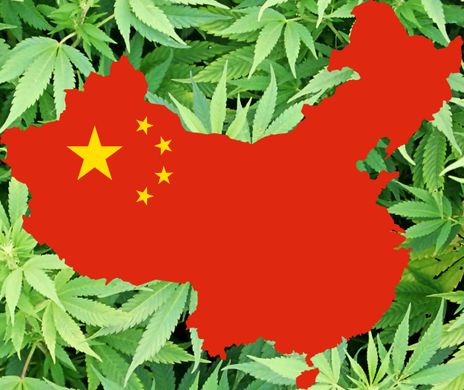China is capitalizing on the rise of medical cannabis
By the time we reach 2024, the industry is forecast to reach up to $4.4 billion in China

As most people already know, a lot of things are stamped with the words “Made in China” on them. After all, China is a hub for creation and innovation. From big-name clothing brands like Prada and Burberry, to the Apple and Android devices that many of us rely on in everyday life, a large chunk of global goods production takes place in the gigantic Asian country.
Amidst the emergence of medical cannabis, it seems that Chinese cultivators want in. An ever-expanding umbrella of scientific research is pointing to the cannabis and hemp plant’s therapeutic qualities, which range from nausea and pain-relief to enhanced mood and overall wellbeing.
What is CBD?
 CBD is a non-psychoactive compound that does not leave the consumer feeling intoxicated, sedated or “high.” Rather, it can counteract psychoactivity caused by the compound’s mind-altering cousin cannabinoid, tetrahydrocannabinol (THC).
CBD is a non-psychoactive compound that does not leave the consumer feeling intoxicated, sedated or “high.” Rather, it can counteract psychoactivity caused by the compound’s mind-altering cousin cannabinoid, tetrahydrocannabinol (THC).
THC is a chemical compound that occurs naturally in cannabis plants. Some of its uses in the medical industry include the treatment of nausea and vomiting, pain, spasticity, movement disorders, glaucoma and epilepsy. Although THC possesses numerous therapeutic qualities, we will focus our attention on CBD for now.
Over the last couple of years, in-depth research into cannabis and hemp-derived CBD has led to a surge in medical cannabis prescriptions throughout the United States. So far, 33 U.S. States and the District of Columbia have legalized cannabis for medical purposes.
China has managed to firmly root itself in the global hemp industry, with the country’s market supplying half of the world’s hemp. Currently, it is not legal to consume CBD in China; the country’s drug laws being among the harshest on the planet. Nonetheless, investors are seriously interested in yielding the powerhouse plants on Chinese territory. After all, demand for CBD is soaring on a global scale.
Chinese companies are growing hemp to produce CBD
Some of the Asian country’s most densely populated regions are, slowly but surely, becoming pioneers in growing weed for the production of cannabidiol (CBD). One of the very first Chinese companies to obtain a cultivation license in Southern China was Hanma Investment Group. The company bagged a license to grow the CBD-rich hemp plant back in 2017.
Located to the west of the capital of Yunnan Province is a valley called Shanchong, where over 1,600 acres of hemp is being cultivated by Hanma’s subsidiary, Hempsoul. More are likely to follow suit, considering the sheer size of Asia’s medical cannabis markets.
Based on data released in The Asian Cannabis Report, the continent’s most valuable medicinal cannabis markets can be found in China and Japan. By 2024, the industry is forecast to reach up to $4.4 billion in China and $800 million in Japan. If these figures are accurate, both industries combined would constitute an incredible 90 percent of Asia’s market.
Asia’s medical cannabis market value predicted to reach $5.8 billion by 2024
 Analysts believe that the value of Asia’s medical cannabis market could soar to $5.8 billion within the next five years. This figure was drawn from the Asian Cannabis Report, which was recently published by data and intelligence firm Prohibition Partners.
Analysts believe that the value of Asia’s medical cannabis market could soar to $5.8 billion within the next five years. This figure was drawn from the Asian Cannabis Report, which was recently published by data and intelligence firm Prohibition Partners.
It is the first in-depth report spotlighting Asia’s legal cannabis industry. The firm believes that in the event legislation sweeps across more of the Asian continent, the report’s predictions are likely to quadruple by 2027. Prohibition Partners’ team of analysts determined that the prevalence of annual cannabis consumption in Asia rests at around two percent of the population. While this might seem small, two percent is equivalent to 86 million people living on the planet’s most densely populated continent.
When compared with other regions, nations and countries that have adopted medical cannabis laws, consumption of the plant in its medicinal form is anticipated to rise quicker in Asia. For this reason, among many others, China and other Asian countries stand a good chance of grasping the attention of overseas investors, operators and producers who are interested in the market’s long-term potential.
Chinese farmers can rake in the cash with cannabis cultivation
China has been growing weed for thousands of years for the production of traditional medicine, textiles, cannabis/hemp oils, and seeds. Despite the rise in demand for CBD products, legalizing cannabis in China is most definitely not on the horizon.
After its inauguration in 1949, the People’s Republic of China introduced harsh laws for traffickers, cultivators, and consumers. In 2010, the Asian country eased up on laws surrounding industrial hemp, meaning that cultivation and production ensued. Nowadays, hemp-derived CBD can be infused into topicals, oral supplements, suppositories, tinctures, oils, and edibles.
Since Chinese farmers can earn $300 per acre of hemp grown, the prospect of cultivating the plant to produce CBD is much more attractive than the idea of raking in lower wages with flax or rapeseed crops. Plus, with China’s mild climate, the cannabis and hemp cultivation potential is prime in this part of the world.








